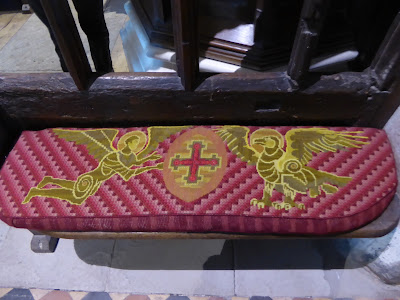An Ulpha Circuit with the Duddon Valley Local History Group.
A sunny day in lakeless lakeland tempted a good turnout for the walk through Duddon history on Saturday. Setting out off the road leading to Ulpha Bridge we walked up the fell-side east of the river to our first destination
the old Quaker Burial Ground known as the Quakers' Sepulcher, my first sight was of the beautifully crafted wall which encloses this peaceful space.
Burials took place here between 1662-1775. We appreciated the walled enclosure with its interior inset slate seats then took care to duck down under the low entrance to leave while mountain bikers waited to let the crowd pass.
After burial ceased here an apple orchard was planted but no trace of them remain, the only trees now are a scattering of firs. We leave heading for Kiln Bank with views of the valley
the sky full of clouds with slants of sunlight highlighting patches of the field system. The scattering of houses and lone farms
and old slate workings entertain the eye. We continued down the gentle path and reach the valley bottom
over the stream past 'The Fairy Bridge' in actuality built in the 1960s to show how a bridge was built -
only fairies may cross. We cross the valley floor over Hall Bridge
 |
| Nook steps and Hall Bridge |
and start to climb stopping part way up
to have lunch where there were plenty of nice flat slates to sit on
at Commonwoods Slate Quarry. Our ultimate destination was further up
 |
| Ken stops to get his notes out to elucidate us all |
to what is left of the Commonwoods slate dressing plateau.
There are many small ruined buildings, I think one would need plenty of shelter from the weather up here although this is a nice seat on a sunny day.
The slate workings building with pointed peak of Caw in the background.
The light playing on the hills with the steep slate quarry in the foreground.
Here is someone who has visited the mines beneath. We however stayed under the ever changing skies
headed downwards past the mossy remains of Grimecrag House.
which dates from the 17th Century. Built in one long range across the hillside it consists of a 3 bay house with 4 bay barn. Alan commented that the name Grimecrag would not have attracted a bride to this location in those day of old. Today with it view of the Duddon to the coast it might have been more attractively called Sea View. The old tree trunk in the foreground held a nice surprise
in this year of abundant fungi some had made a home here. Downward we continued by
Crosby Gill and past Grimecrag Bridge
through Hazel Head Farm, the group splintered when a few were tempted in to the
Hesk View Walkers Barn with its cake and tea signpost but only with time to look around and think next time we might have time to stop but we had to catch up with our party.
We admired the bank barn on the way past. Joining the Birker Fell Road and across the fields to the gate by
the charming Ulpha Post Office (opened in 1890). Buy your postcards here and post in
the Victoria Regina post box manufactured by WT Allen. However it was only ice creams to be licked for us on this day rather than stamps.
A dated (1709 or 1769) gate stoop to gaze at and a visit to the idylic St John's Church
and enjoy its wall decorations. This is dedicated to one of the Dansons (1793) who gave the church its lynchgate and oak porch (replaced in 1961 with a stone porch). We give thanks for the day and return to our cars.


























































